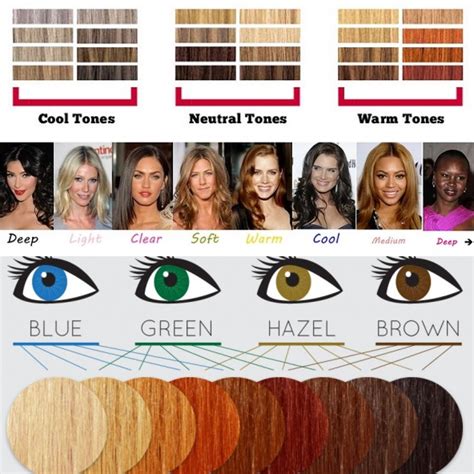- Understanding Skin Tones
- Warm vs. Cool Skin Tones
- Best Hair Colors for Warm Skin Tones
- Best Hair Colors for Cool Skin Tones
- Hair Color Ideas for Neutral Skin Tones
- Common Mistakes to Avoid
- Why Choosing the Right Hair Color Matters
- Benefits of Choosing the Right Hair Color
- FAQs
Skin tones can be classified into three main categories: warm, cool, and neutral. Warm skin tones have yellow or golden undertones, while cool skin tones have pink or bluish undertones. Neutral skin tones have a mix of both warm and cool undertones.

To determine your skin tone, hold a white piece of paper next to your face in natural light. If your skin looks yellowish or golden, you have a warm skin tone. If your skin looks pink or bluish, you have a cool skin tone. If your skin looks a combination of both, you have a neutral skin tone.
Warm skin tones look best with hair colors that have warm undertones, such as:
- Golds: Golden blonde, honey blonde, caramel, and auburn
- Reds: Copper, strawberry blonde, and burgundy
- Browns: Warm brown, chocolate brown, and cinnamon brown
Cool skin tones look best with hair colors that have cool undertones, such as:
- Silvers: Platinum blonde, icy blonde, and silver
- Blues: Ash blonde, blue-black, and denim
- Greens: Emerald green and forest green
Neutral skin tones can wear a wider range of hair colors, including both warm and cool tones. However, it is important to avoid colors that are too extreme, as they can wash out your complexion.
Some flattering hair color ideas for neutral skin tones include:
- Blondes: Golden blonde, honey blonde, ash blonde, and platinum blonde
- Brunettes: Warm brown, chocolate brown, cool brown, and black
- Reds: Copper, strawberry blonde, burgundy, and auburn
When choosing a hair color, there are a few common mistakes to avoid:
- Choosing a color that is too dark or too light: A color that is too dark can make you look washed out, while a color that is too light can make you look harsh.
- Choosing a color that is too warm or too cool: A color that is too warm can make you look yellow, while a color that is too cool can make you look blue.
- Choosing a color that does not complement your eye color: Your hair color should complement your eye color, not clash with it.
Choosing the right hair color can make a big difference in your overall appearance. It can flatter your skin tone, make you look younger, and boost your confidence.
According to a study published in the Journal of Cosmetic Dermatology, people who choose the right hair color for their skin tone are perceived as more attractive, more trustworthy, and more intelligent.
Choosing the right hair color can provide a number of benefits, including:
- Flattering your skin tone: The right hair color can make you look more radiant and youthful.
- Making you look younger: A well-chosen hair color can help to reduce the appearance of wrinkles and fine lines.
- Boosting your confidence: When you look good, you feel good. Choosing the right hair color can give you a boost of confidence.
Q: How often should I change my hair color?
A: The frequency with which you change your hair color depends on your personal preference and hair growth rate. However, most experts recommend changing your hair color every 6-8 weeks.
Q: Can I change my hair color at home?
A: Yes, you can change your hair color at home using a box dye. However, it is important to follow the instructions carefully and to do a patch test first to make sure that you are not allergic to the dye.
Q: What is the best way to maintain my hair color?
A: The best way to maintain your hair color is to use color-safe shampoo and conditioner. You should also avoid using heat styling tools as much as possible, as they can damage your hair and cause the color to fade.
Q: What are some of the latest hair color trends?
A: Some of the latest hair color trends include:
- Balayage: A highlighting technique that creates a natural-looking, sun-kissed effect.
- Ombré: A hair color technique that involves gradually blending two or more shades of hair color.
- Sombre: A hair color technique that is similar to ombré, but with a softer, more subtle blend of colors.
